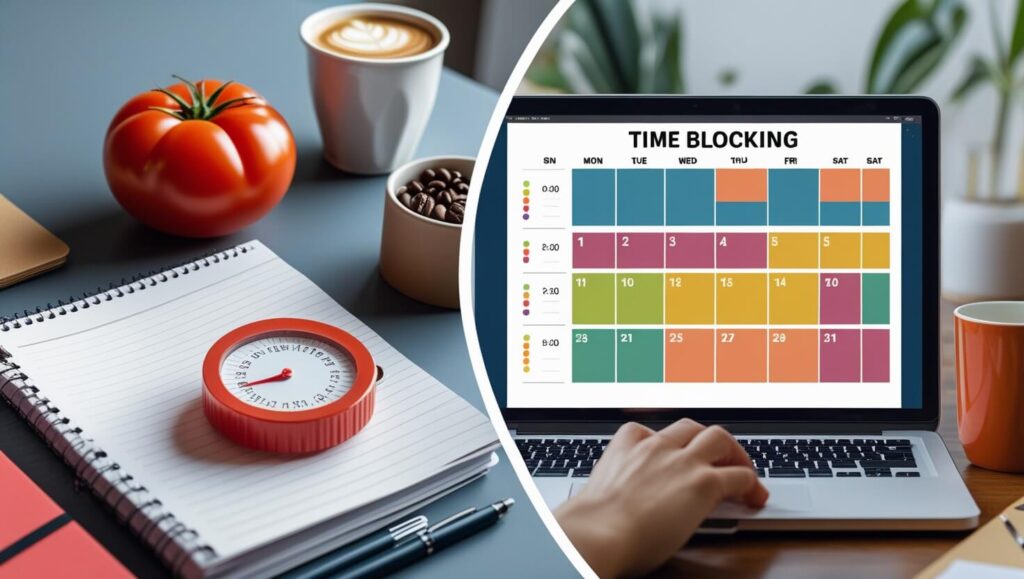Managing your time can be difficult, especially with endless distractions. The Pomodoro Technique is one of the most popular time management techniques used to stay focused and productive. But there’s another way to focus – time blocking. Both strategies promise better focus, better work performance, and a more organized day. But which is better?
In this article, we’ll compare the Pomodoro Technique and time blocking to help you decide which one suits your goals. Whether you’re looking to increase productivity, improve concentration, or just better organize your tasks, it’s important to understand these methods.
The Pomodoro Technique involves short bursts of focused work followed by breaks. It’s great for avoiding burnout and keeping your mind fresh. Time blocking, on the other hand, assigns specific tasks to set time slots. It gives your day a clear structure and reduces time wasted.
Each method has its own advantages and disadvantages. So, choosing the right one depends on your work style and daily routine. Let’s dive deeper into both techniques. By the end, you’ll know exactly which time tracking method will help you get more done — with less stress.
Understanding the Fundamentals
When it comes to time management techniques, understanding the basics is the first step towards increasing productivity and improving your daily routine. Let’s explore what the Pomodoro Technique and time blocking are all about.
What is the Pomodoro Technique?
The Pomodoro Technique is a simple but powerful productivity method developed by Francesco Cirillo in the late 1980s. It focuses on short bursts of focused work followed by short breaks. Traditionally, you work for 25 minutes (a “Pomodoro”) and then take a 5-minute break. Every achievement boosts your drive to achieve more.
This method helps you maintain focus and concentration, reduces mental fatigue, and makes large tasks feel more manageable. Because it breaks down time into smaller chunks, it’s great for people who struggle with procrastination or distractions. The technique also improves work performance by creating a sense of urgency and rhythm throughout your day.
What is Time Blocking?
Time blocking is another highly effective time management strategy. Instead of working in short sprints, you divide your entire day into blocks of time dedicated to specific tasks. For example, you might block out 9-11am for writing, 11-12pm for meetings, and so on.
This technique provides structure to your day and helps prevent multitasking. It’s especially useful for professionals who juggle multiple responsibilities. By assigning a goal to each hour, time blocking helps you stay on track, limit distractions, and increase productivity.
Both methods are designed to help you take control of your time. But they take different approaches—one is flexible and rhythmic, while the other is structured and planned. Next, we’ll explore the benefits of each to help you choose the best fit for your workflow.
Comparing Core Features
Understanding the key differences between the Pomodoro Technique and time blocking can help you choose the right method for your productivity needs. Let’s compare how these two time management techniques differ in terms of structure, focus, and planning.
Structure and Flexibility
The Pomodoro Technique offers a highly structured yet flexible way to work. Each 25-minute session is scheduled, followed by short breaks. However, the tasks within each session can vary. You are free to adjust your work based on priority, but the time intervals remain the same.
In contrast, time blocking provides structure for your entire day. You assign specific time slots to specific tasks or categories. This creates a clear roadmap of what needs to be done and when. While it brings strong organization, it can be less flexible if unexpected tasks arise or obstacles arise.
Focus Style
Both methods aim to increase productivity and improve focus and concentration, but they do so in different ways.
The Pomodoro Technique increases focus through short sprints. Knowing that a break is coming soon keeps your mind sharp and prevents burnout. This is especially helpful for repetitive tasks or when motivation is low.
Time blocking, on the other hand, promotes deep work. It allows for long periods of uninterrupted focus on complex or creative tasks. You immerse yourself deeper in your work without changing context, making it ideal for professionals and creatives.
Planning Approach
Planning with the Pomodoro Technique is easy. You break your tasks into small, manageable chunks that can be fit into 25-minute sessions. It’s great for people who prefer a lighter planning style or need a boost to get started.
Time blocking requires more advance planning. You schedule your entire day or week, mapping out what you’ll do hour by hour. While it takes more effort initially, it gives you full control over your time and helps prevent decision fatigue.
In short, the Pomodoro Technique is more flexible and action-oriented, while time blocking is structured and strategic. The choice you make depends on your work style and how much control you want over your schedule.
Benefits and Drawbacks
Both the Pomodoro Technique and time blocking are powerful tools for improving time management and productivity. However, each method has its own strengths and weaknesses, depending on your working style and goals.
Pros and Cons of Pomodoro Technique
Pros:
- Boosts focus and concentration: Short 25-minute sessions help you stay engaged without burning out.
- Reduces procrastination: The limited time frame creates a sense of urgency to get started.
- Prevents burnout: Regular breaks support mental rest and recovery.
- Simple and easy to start: You don’t need a complicated plan—just a timer and a task list.
- Improves work efficiency: Helps break large tasks into smaller, more manageable chunks.
Cons:
- Not ideal for deep work: The frequent breaks can disrupt flow when working on complex or creative tasks.
- Rigid time intervals: The fixed 25/5-minute pattern might not fit all types of work or energy levels.
- Can feel repetitive: Some users may find the constant cycle of work and break too monotonous.
The Pomodoro Technique works best for tasks that require sustained attention but not prolonged deep thinking. It’s great for students, writers, or anyone struggling with distractions or procrastination.
Pros and Cons of Time Blocking
Pros:
- Provides structure and clarity: You know exactly what to do and when, reducing decision fatigue.
- Promotes deep focus: Long, uninterrupted blocks allow you to dive into meaningful work.
- Great for managing multiple priorities: Time Blocking helps allocate time to all key areas of your life or job.
- Helps eliminate multitasking: Encourages one-task-at-a-time focus.
- Boosts productivity with planning: Keeps your day intentional and goal-driven.
Cons:
- Requires detailed planning: Pre-scheduling your entire day takes time and discipline.
- Lack of flexibility: Unexpected tasks or interruptions can throw off your whole schedule.
- Can feel overwhelming: Seeing every hour blocked might create pressure or anxiety.
Time Blocking is perfect for professionals, entrepreneurs, and planners who thrive on structure and long-term productivity.
Outbound Resources

Ideal Use Cases
The choice between the Pomodoro Technique and time blocking depends on your work style, goals, and daily demands. Each method is better in different situations.
When to Choose Pomodoro Technique
The Pomodoro Technique is ideal if you struggle with staying focused or have a tendency to procrastinate. It’s perfect for students, remote workers, or anyone who is busy with small tasks throughout the day. If you get distracted easily or find yourself rushing through long work sessions, Pomodoro helps you pick up the pace with short, timed bursts.
It’s also a great method for tasks like writing, coding, studying, or answering emails — where sustained attention and short breaks improve work performance and mental clarity. If you’re new to time management techniques, Pomodoro is easy to implement and doesn’t require much planning.
When Time Blocking Excels
Time blocking works best when you need a clear daily structure or handle multiple responsibilities. It’s a great choice for professionals, entrepreneurs, and project managers who need to plan their days with precision.
If you handle large projects, intensive work, or creative tasks that require a lot of focus, time blocking allows you to dive deep without interruption. It helps you prioritize, avoid multitasking, and increase long-term productivity.
In short, use Pomodoro for short tasks and motivation, and choose Time Blocking for structure and strategic planning.
Hybrid Approaches
You don’t have to choose between the Pomodoro Technique and time blocking—you can create a powerful hybrid system by combining the two. Many productivity experts use a blended approach to get the best of both worlds.
Start by using time blocking to schedule your day. Block out time for focused work, meetings, breaks, and admin tasks. Then, within those blocks, apply the Pomodoro Technique to stay on task and maintain high energy. For example, during a two-hour writing block, use four Pomodoro sessions with breaks in between.
This combination improves focus and concentration, keeps your day organized, and helps you avoid burnout. It also gives you flexibility within a strict framework, balancing deep work with mental rest. The hybrid model is especially effective for remote workers, freelancers, and anyone who manages creative and administrative tasks.
Using both techniques, you can gain complete control over your time, stay motivated, and truly increase productivity. The key is to experiment and adjust based on your workflow.
Tools & Expert Recommendations
To get started with the Pomodoro technique, or time blocking, using the right tools can make a big difference. For Pomodoro, popular apps like Focus To Do, Pomo Focus, and Forest help you track work sessions and break times. These tools keep you accountable and make time tracking easy.
For time blocking, try digital calendars like Google Calendar or tools like TickTick and Notion. They let you visually organize your day and adjust your schedule with ease.
Experts recommend starting small. Try each method for a week and track your focus and productivity. You can even combine the two for maximum results. According to productivity coaches, the best time management techniques are those you can stick to consistently.
Use these tools to customize your routine, stay organized, and increase your daily productivity. With practice, you will find the system that suits your lifestyle and work habits.
Psychological Insights
Both the Pomodoro Technique and time blocking use psychological principles that increase focus, motivation, and productivity. The Pomodoro Technique takes advantage of the Zeigarnik Effect, which suggests that people are more likely to complete tasks that are interrupted because unfinished tasks stay on top of our minds. By working in short bursts, you create a sense of urgency and accomplishment while keeping distractions at bay.
Time blocking, on the other hand, uses the concept of cognitive load. By clearly defining the boundaries of the task, it reduces decision fatigue and mental clutter. Knowing what to focus on during each block of time helps maintain mental clarity and ensures that work performance remains high throughout the day.
Both methods also promote a sense of control, which can reduce stress and increase motivation. By managing your time strategically, you increase your ability to stay engaged and productive.
For deeper focus strategies, explore how to create a SMART goal and build good habits fast.
Which Should You Choose?
Both the Pomodoro Technique and time blocking offer unique benefits for time management and productivity. If you struggle with distractions and need flexible, short-term attention spans, the Pomodoro Technique is a great choice. However, if you need a structured, strategic approach to managing multiple tasks or deep work, time blocking is ideal.
For best results, consider combining both methods to maintain balance, structure, and focus. Choose a technique that suits your work style, and experiment with what works best for you.




Thank you so much for your beautiful words. It truly means a lot to know that the writing gave you a moment to pause and reflect—that’s exactly what I hope to offer through my work. Your comment encourages me to keep writing with intention and heart. I’m really grateful you took the time to share this.
Thank you! I’m happy to hear you found the information useful — I appreciate you taking the time to read and share your thoughts.